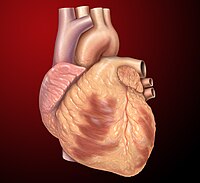
Photo from wikipedia
Abstract OBJECTIVES The severity of acute papillary muscle (PM) rupture varies according to the extent and site of the rupture. However, the haemodynamic effects of different rupture variations are still… Click to show full abstract
Abstract OBJECTIVES The severity of acute papillary muscle (PM) rupture varies according to the extent and site of the rupture. However, the haemodynamic effects of different rupture variations are still poorly understood. Using a novel ex vivo model, we sought to study acute PM rupture to improve clinical management. METHODS Using porcine mitral valves (n = 32) mounted within an ex vivo left heart simulator, PM rupture was simulated. The mitral valve was divided into quadrants for analysis according to the PM heads. Acute PM rupture was simulated by incrementally cutting from 1/3 to the total number of chordae arising from 1 PM head of interest. Haemodynamic parameters were measured. RESULTS Rupture >2/3 of the chordae from 1 given PM head or regurgitation fraction >60% led to markedly deteriorated haemodynamics. Rupture at the anterolateral PM had a stronger negative effect on haemodynamics than rupture at the posteromedial PM. Rupture occurring at the anterior head of the anterolateral PM led to more marked haemodynamic instability than rupture occurring at the other PM heads. CONCLUSIONS The haemodynamic effects of acute PM rupture vary considerably according to the site and extent of the rupture. Rupture of ≤2/3 of chordae from 1 PM head or rupture at the posteromedial PM lead to less marked haemodynamics effects, suggesting a higher likelihood of tolerating surgery. Rupture at the anterolateral PM, specifically the anterior head, rupture of >2/3 of chordae from 1 PM head or regurgitation fraction >60% led to marked haemodynamic instability, suggesting the potential benefit from bridging strategies prior to surgery.
Journal Title: Interactive Cardiovascular and Thoracic Surgery
Year Published: 2022
Link to full text (if available)
Share on Social Media: Sign Up to like & get
recommendations!